
Mooncake
Mooncake is the serving platform for Kimi, a leading LLM service provided by Moonshot AI.
Stars: 4004
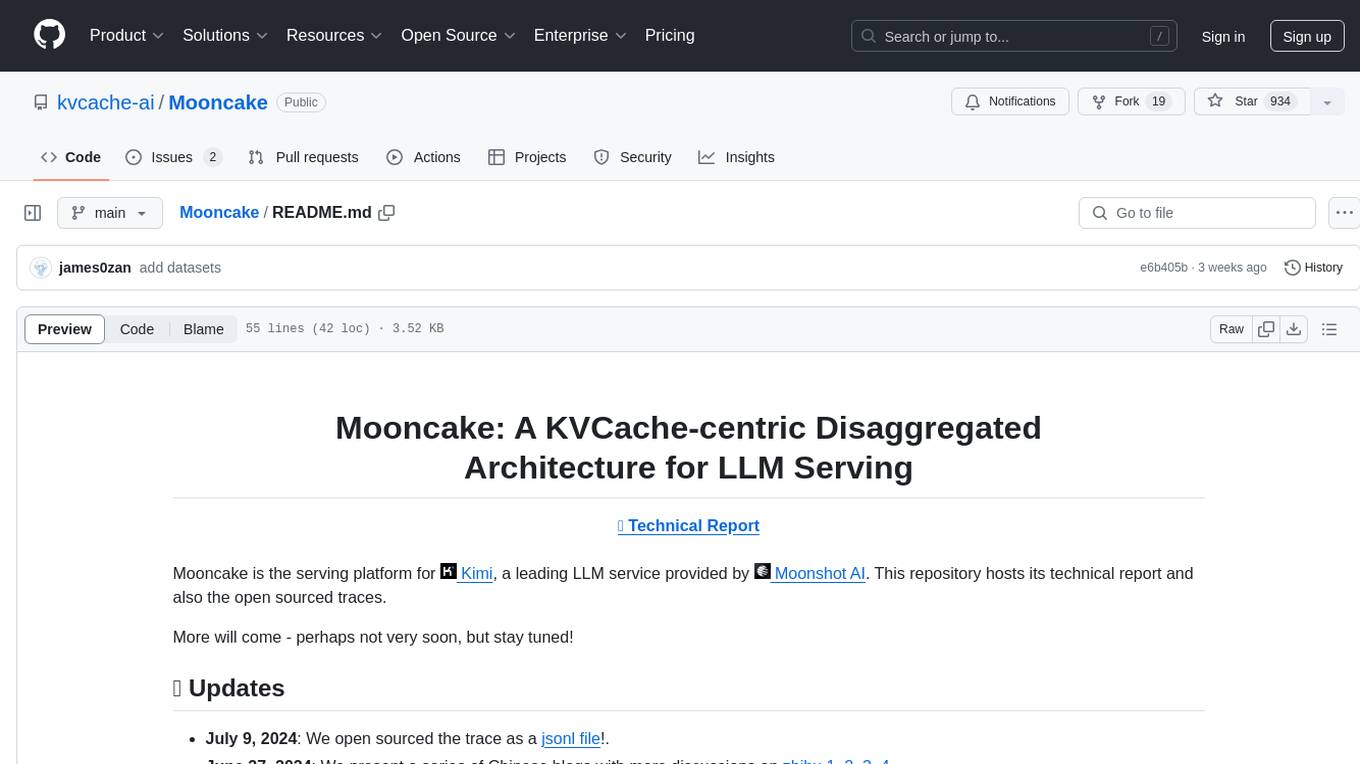
Mooncake is a serving platform for Kimi, a leading LLM service provided by Moonshot AI. It features a KVCache-centric disaggregated architecture that separates prefill and decoding clusters, leveraging underutilized CPU, DRAM, and SSD resources of the GPU cluster. Mooncake's scheduler balances throughput and latency-related SLOs, with a prediction-based early rejection policy for highly overloaded scenarios. It excels in long-context scenarios, achieving up to a 525% increase in throughput while handling 75% more requests under real workloads.
README:
Mooncake is the serving platform for  Kimi, a leading LLM service provided by
Kimi, a leading LLM service provided by  Moonshot AI.
Now both the Transfer Engine and Mooncake Store are open-sourced!
This repository also hosts its technical report and the open sourced traces.
Moonshot AI.
Now both the Transfer Engine and Mooncake Store are open-sourced!
This repository also hosts its technical report and the open sourced traces.
- Sept 10, 2025: SGLang officially supports Mooncake Store as a hierarchical KV caching storage backend. The integration extends RadixAttention with multi-tier KV cache storage across device, host, and remote storage layers.
- Sept 10, 2025: The official & high-performance version of Mooncake P2P Store is open-sourced as checkpoint-engine. It has been successfully applied in K1.5 and K2 production training, updating Kimi-K2 model (1T parameters) across thousands of GPUs in ~20s.
- Aug 23, 2025: xLLM high-performance inference engine builds hybrid KV cache management based on Mooncake, supporting global KV cache management with intelligent offloading and prefetching.
- Aug 18, 2025: vLLM-Ascend integrates Mooncake Transfer Engine for KV cache register and disaggregate prefill, enabling efficient distributed inference on Ascend NPUs.
- Jul 20, 2025: Mooncake powers the deployment of Kimi K2 on 128 H200 GPUs with PD disaggregation and large-scale expert parallelism, achieving 224k tokens/sec prefill throughput and 288k tokens/sec decode throughput.
- Jun 20, 2025: Mooncake becomes a PD disaggregation backend for LMDeploy.
- May 9, 2025: NIXL officially supports Mooncake Transfer Engine as a backend plugin.
- May 8, 2025: Mooncake x LMCache unite to pioneer KVCache-centric LLM serving system.
- May 5, 2025: Supported by Mooncake Team, SGLang release guidance to deploy DeepSeek with PD Disaggregation on 96 H100 GPUs.
- Apr 22, 2025: LMCache officially supports Mooncake Store as a remote connector.
- Apr 10, 2025: SGLang officially supports Mooncake Transfer Engine for disaggregated prefilling and KV cache transfer.
- Mar 7, 2025: We open sourced the Mooncake Store, a distributed KVCache based on Transfer Engine. vLLM's xPyD disaggregated prefilling & decoding based on Mooncake Store will be released soon.
- Feb 25, 2025: Mooncake receives the Best Paper Award at FAST 2025!
- Feb 21, 2025: The updated traces used in our FAST'25 paper have been released.
- Dec 16, 2024: vLLM officially supports Mooncake Transfer Engine for disaggregated prefilling and KV cache transfer.
- Nov 28, 2024: We open sourced the Transfer Engine, the central component of Mooncake. We also provide two demonstrations of Transfer Engine: a P2P Store and vLLM integration.
- July 9, 2024: We open sourced the trace as a jsonl file.
- June 27, 2024: We present a series of Chinese blogs with more discussions on zhihu 1, 2, 3, 4.
- June 26, 2024: Initial technical report release.
Mooncake features a KVCache-centric disaggregated architecture that separates the prefill and decoding clusters. It also leverages the underutilized CPU, DRAM, and SSD resources of the GPU cluster to implement a disaggregated cache of KVCache.
The core of Mooncake is its KVCache-centric scheduler, which balances maximizing overall effective throughput while meeting latency-related Service Level Objectives (SLOs) requirements. Unlike traditional studies that assume all requests will be processed, Mooncake faces challenges due to highly overloaded scenarios. To mitigate these, we developed a prediction-based early rejection policy. Experiments show that Mooncake excels in long-context scenarios. Compared to the baseline method, Mooncake can achieve up to a 525% increase in throughput in certain simulated scenarios while adhering to SLOs. Under real workloads, Mooncake’s innovative architecture enables Kimi to handle 75% more requests.
Mooncake Core Component: Transfer Engine (TE)
The core of Mooncake is the Transfer Engine (TE), which provides a unified interface for batched data transfer across various storage devices and network links. Supporting multiple protocols including TCP, RDMA, CXL/shared-memory, and NVMe over Fabric (NVMe-of), TE is designed to enable fast and reliable data transfer for AI workloads. Compared to Gloo (used by Distributed PyTorch) and traditional TCP, TE achieves significantly lower I/O latency, making it a superior solution for efficient data transmission.
P2P Store and Mooncake Store
Both P2P Store and Mooncake Store are built on the Transfer Engine and provide key/value caching for different scenarios. P2P Store focuses on sharing temporary objects (e.g., checkpoint files) across nodes in a cluster, preventing bandwidth saturation on a single machine. Mooncake Store, on the other hand, supports distributed pooled KVCache, specifically designed for XpYd disaggregation to enhance resource utilization and system performance.
Mooncake Integration with Leading LLM Inference Systems
Mooncake has been seamlessly integrated with several popular large language model (LLM) inference systems. Through collaboration with the vLLM and SGLang teams, Mooncake now officially supports prefill-decode disaggregation. By leveraging the high-efficiency communication capabilities of RDMA devices, Mooncake significantly improves inference efficiency in prefill-decode disaggregation scenarios, providing robust technical support for large-scale distributed inference tasks.
In addition, Mooncake has been successfully integrated with SGLang's Hierarchical KV Caching, vLLM's prefill serving, and LMCache, augmenting KV cache management capabilities across large-scale inference scenarios.
Elastic Expert Parallelism Support (Work in Progress) Mooncake adds elasticity and fault tolerance support for MoE model inference, enabling inference systems to remain responsive and recoverable in the event of GPU failures or changes in resource configuration. This functionality includes automatic faulty rank detection and can incorporate with the EPLB module to dynamically route tokens to healthy ranks during inference.
Use Transfer Engine Standalone (Guide)
Transfer Engine is a high-performance data transfer framework. Transfer Engine provides a unified interface to transfer data from DRAM, VRAM or NVMe, while the technical details related to hardware are hidden. Transfer Engine supports TCP, RDMA (InfiniBand/RoCEv2/eRDMA/NVIDIA GPUDirect) and NVMe over Fabric (NVMe-of) protocols.
-
Efficient use of multiple RDMA NIC devices. Transfer Engine supports the use of multiple RDMA NIC devices to achieve the aggregation of transfer bandwidth.
-
Topology aware path selection. Transfer Engine can select optimal devices based on the location (NUMA affinity, etc.) of both source and destination.
-
More robust on temporary network error. Once transmission fails, Transfer Engine will try to use alternative paths for data delivery automatically.
With 40 GB of data (equivalent to the size of the KVCache generated by 128k tokens in the LLaMA3-70B model), Mooncake Transfer Engine delivers up to 87 GB/s and 190 GB/s of bandwidth in 4×200 Gbps and 8×400 Gbps RoCE networks respectively, which are about 2.4x and 4.6x faster than the TCP protocol.
P2P Store (Guide)
P2P Store is built on the Transfer Engine and supports sharing temporary objects between peer nodes in a cluster. P2P Store is ideal for scenarios like checkpoint transfer, where data needs to be rapidly and efficiently shared across a cluster. P2P Store has been used in the checkpoint transfer service of Moonshot AI.
-
Decentralized architecture. P2P Store leverages a pure client-side architecture with global metadata managed by the etcd service.
-
Efficient data distribution. Designed to enhance the efficiency of large-scale data distribution, P2P Store avoids bandwidth saturation issues by allowing replicated nodes to share data directly. This reduces the CPU/RDMA NIC pressures of data providers (e.g., trainers).
Mooncake Store (Guide)
Mooncake Store is a distributed KVCache storage engine specialized for LLM inference based on Transfer Engine. It is the central component of the KVCache-centric disaggregated architecture. The goal of Mooncake Store is to store the reusable KV caches across various locations in an inference cluster. Mooncake Store has been supported in SGLang's Hierarchical KV Caching, vLLM's prefill serving and is now integrated with LMCache to provide enhanced KVCache management capabilities.
-
Multi-replica support: Mooncake Store supports storing multiple data replicas for the same object, effectively alleviating hotspots in access pressure.
-
High bandwidth utilization: Mooncake Store supports striping and parallel I/O transfer of large objects, fully utilizing multi-NIC aggregated bandwidth for high-speed data reads and writes.
SGLang Integration (Guide)
SGLang officially supports Mooncake Store as a HiCache storage backend. This integration enables scalable KV cache retention and high-performance access for large-scale LLM serving scenarios.
- Hierarchical KV Caching: Mooncake Store serves as an external storage backend in SGLang's HiCache system, extending RadixAttention with multi-level KV cache storage across device, host, and remote storage layers.
- Flexible Cache Management: Supports multiple cache policies including write-through, write-through-selective, and write-back modes, with intelligent prefetching strategies for optimal performance.
- Comprehensive Optimizations: Features advanced data plane optimizations including page-first memory layout for improved I/O efficiency, zero-copy mechanisms for reduced memory overhead, GPU-assisted I/O kernels delivering fast CPU-GPU transfers, and layer-wise overlapping for concurrent KV cache loading while computation executes.
- Significant Performance Gains: The multi-turn benchmark demonstrates substantial performance improvements over the non-HiCache setting. See our benchmark report for more details.
- Community Feedback: Effective KV caching significantly reduces TTFT by eliminating redundant and costly re-computation. Integrating SGLang HiCache with the Mooncake service enables scalable KV cache retention and high-performance access. In our evaluation, we tested the DeepSeek-R1-671B model under PD-disaggregated deployment using in-house online requests sampled from a general QA scenario. On average, cache hits achieved an 84% reduction in TTFT compared to full re-computation. – Ant Group
vLLM Integration (Guide v0.2)
To optimize LLM inference, the vLLM community is working on supporting disaggregated prefilling (PR 10502). This feature allows separating the prefill phase from the decode phase in different processes. The vLLM uses nccl and gloo as the transport layer by default, but currently it cannot efficiently decouple both phases in different machines.
We have implemented vLLM integration, which uses Transfer Engine as the network layer instead of nccl and gloo, to support inter-node KVCache transfer (PR 10884). Transfer Engine provides simpler interfaces and more efficient use of RDMA devices.
We will soon release the new vLLM integration based on Mooncake Store, which supports xPyD prefill/decode disaggregation.
Update[Dec 16, 2024]: Here is the latest vLLM Integration (Guide v0.2) that is based on vLLM's main branch.
By supporting Topology Aware Path Selection and multi-card bandwidth aggregation, Mean TTFT of vLLM with Transfer Engine is up to 25% lower than traditional TCP-based transports. In the future, we will further improve TTFT through GPUDirect RDMA and zero-copy.
| Backend/Setting | Output Token Throughput (tok/s) | Total Token Throughput (tok/s) | Mean TTFT (ms) | Median TTFT (ms) | P99 TTFT (ms) |
|---|---|---|---|---|---|
| Transfer Engine (RDMA) | 12.06 | 2042.74 | 1056.76 | 635.00 | 4006.59 |
| TCP | 12.05 | 2041.13 | 1414.05 | 766.23 | 6035.36 |
- Click here to access detailed benchmark results.
More advanced features will coming soon, so stay tuned!
Mooncake is designed and optimized for high-speed RDMA networks. Though Mooncake supports TCP-only data transfer, we strongly recommend users to evaluate the functionality and performance of Mooncake with RDMA network support.
The following needs to be installed before running any component of Mooncake:
- RDMA Driver & SDK, such as Mellanox OFED.
- Python 3.10, virtual environment is recommended.
- CUDA 12.1 and above, including NVIDIA GPUDirect Storage Support, if the package is build with
-DUSE_CUDA(disabled by default). You may install them from here.
The most simple way to use Mooncake Transfer Engine is using pip:
pip install mooncake-transfer-engine[!IMPORTANT] If users encounter problems such as missing
lib*.so, they should uninstall this package bypip uninstall mooncake-transfer-engine, and build the binaries manually.
Mooncake supports Docker-based deployment, see Build Guide in detail.
The following are additional dependencies for building Mooncake:
- Build essentials, including gcc, g++ (9.4+) and cmake (3.16+).
- Go 1.20+, if you want to build with
-DWITH_P2P_STORE,-DUSE_ETCD(enabled by default to use etcd as metadata servers), or-DSTORE_USE_ETCD(use etcd for the failover of the store master). - CUDA 12.1 and above, including NVIDIA GPUDirect Storage Support, if the package is built with
-DUSE_CUDA. This is NOT included in thedependencies.shscript. You may install them from here. - [Optional] Rust Toolchain, if you want to build with
-DWITH_RUST_EXAMPLE. This is NOT included in thedependencies.shscript. - [Optional]
hiredis, if you want to build with-DUSE_REDISto use Redis instead of etcd as metadata servers. - [Optional]
curl, if you want to build with-DUSE_HTTPto use HTTP instead of etcd as metadata servers.
The building and installation steps are the following:
-
Retrieve source code from GitHub repo
git clone https://github.com/kvcache-ai/Mooncake.git cd Mooncake -
Install dependencies
bash dependencies.sh
-
Compile Mooncake and examples
mkdir build cd build cmake .. make -j sudo make install # optional, make it ready to be used by vLLM/SGLang
- [x] First release of Mooncake and integrate with latest vLLM
- [ ] Share KV caches across multiple serving engines
- [ ] User and developer documentation
{
"timestamp": 27482,
"input_length": 6955,
"output_length": 52,
"hash_ids": [46, 47, 48, 49, 50, 51, 52, 53, 54, 55, 56, 57, 2353, 2354]
}
{
"timestamp": 30535,
"input_length": 6472,
"output_length": 26,
"hash_ids": [46, 47, 48, 49, 50, 51, 52, 53, 54, 55, 56, 57, 2366]
}The above presents two samples from our trace dataset. The trace includes the timing of request arrivals, the number of input tokens, the number of output tokens, and the remapped block hash. To protect our customers' privacy, we applied several mechanisms to remove user-related information while preserving the dataset's utility for simulated evaluation. More descriptions of the trace (e.g., up to 50% cache hit ratio) can be found in Section 4 of the technical report.
Update[Feb 21, 2025]: The updated traces used in our FAST'25 paper have been released! Please refer to the paper's appendix (found here) for more details.
Please kindly cite our paper if you find the paper or the traces are useful:@article{qin2024mooncake,
title = {Mooncake: A KVCache-centric Disaggregated Architecture for LLM Serving},
author = {Ruoyu Qin, Zheming Li, Weiran He, Mingxing Zhang, Yongwei Wu, Weimin Zheng, and Xinran Xu},
year = {2024},
url = {https://arxiv.org/abs/2407.00079}
}
@inproceedings {qin2025mooncake,
author = {Ruoyu Qin and Zheming Li and Weiran He and Jialei Cui and Feng Ren and Mingxing Zhang and Yongwei Wu and Weimin Zheng and Xinran Xu},
title = {Mooncake: Trading More Storage for Less Computation {\textemdash} A {KVCache-centric} Architecture for Serving {LLM} Chatbot},
booktitle = {23rd USENIX Conference on File and Storage Technologies (FAST 25)},
year = {2025},
isbn = {978-1-939133-45-8},
address = {Santa Clara, CA},
pages = {155--170},
url = {https://www.usenix.org/conference/fast25/presentation/qin},
publisher = {USENIX Association},
month = feb
}For Tasks:
Click tags to check more tools for each tasksFor Jobs:
Alternative AI tools for Mooncake
Similar Open Source Tools

Mooncake
Mooncake is a serving platform for Kimi, a leading LLM service provided by Moonshot AI. It features a KVCache-centric disaggregated architecture that separates prefill and decoding clusters, leveraging underutilized CPU, DRAM, and SSD resources of the GPU cluster. Mooncake's scheduler balances throughput and latency-related SLOs, with a prediction-based early rejection policy for highly overloaded scenarios. It excels in long-context scenarios, achieving up to a 525% increase in throughput while handling 75% more requests under real workloads.
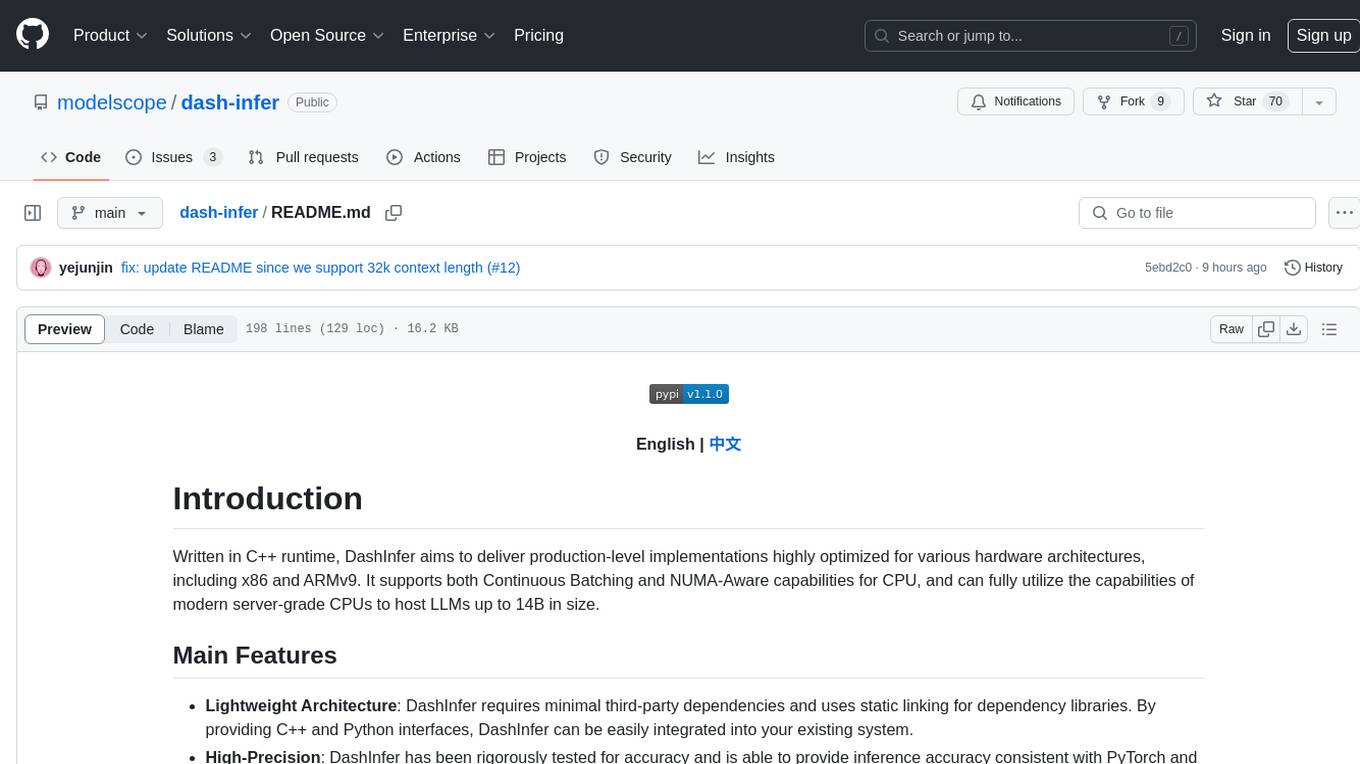
dash-infer
DashInfer is a C++ runtime tool designed to deliver production-level implementations highly optimized for various hardware architectures, including x86 and ARMv9. It supports Continuous Batching and NUMA-Aware capabilities for CPU, and can fully utilize modern server-grade CPUs to host large language models (LLMs) up to 14B in size. With lightweight architecture, high precision, support for mainstream open-source LLMs, post-training quantization, optimized computation kernels, NUMA-aware design, and multi-language API interfaces, DashInfer provides a versatile solution for efficient inference tasks. It supports x86 CPUs with AVX2 instruction set and ARMv9 CPUs with SVE instruction set, along with various data types like FP32, BF16, and InstantQuant. DashInfer also offers single-NUMA and multi-NUMA architectures for model inference, with detailed performance tests and inference accuracy evaluations available. The tool is supported on mainstream Linux server operating systems and provides documentation and examples for easy integration and usage.
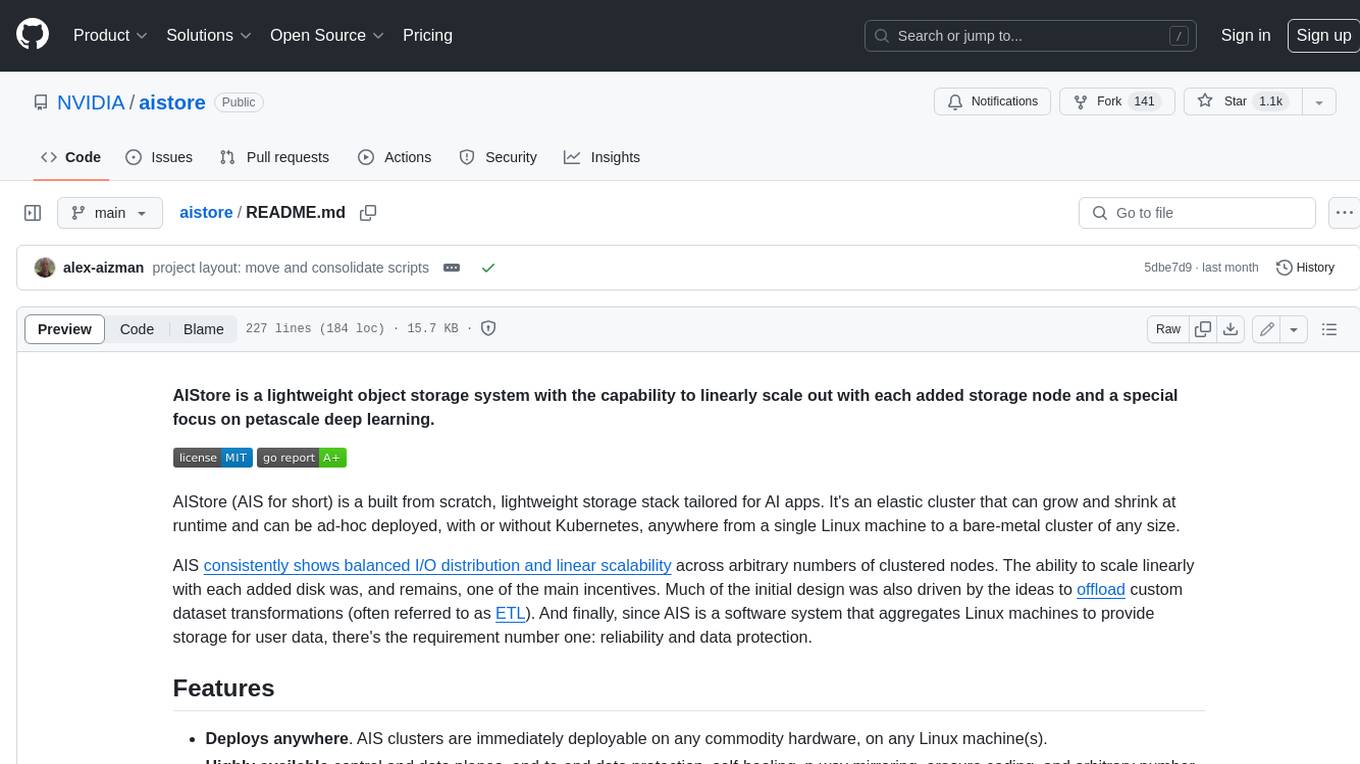
aistore
AIStore is a lightweight object storage system designed for AI applications. It is highly scalable, reliable, and easy to use. AIStore can be deployed on any commodity hardware, and it can be used to store and manage large datasets for deep learning and other AI applications.
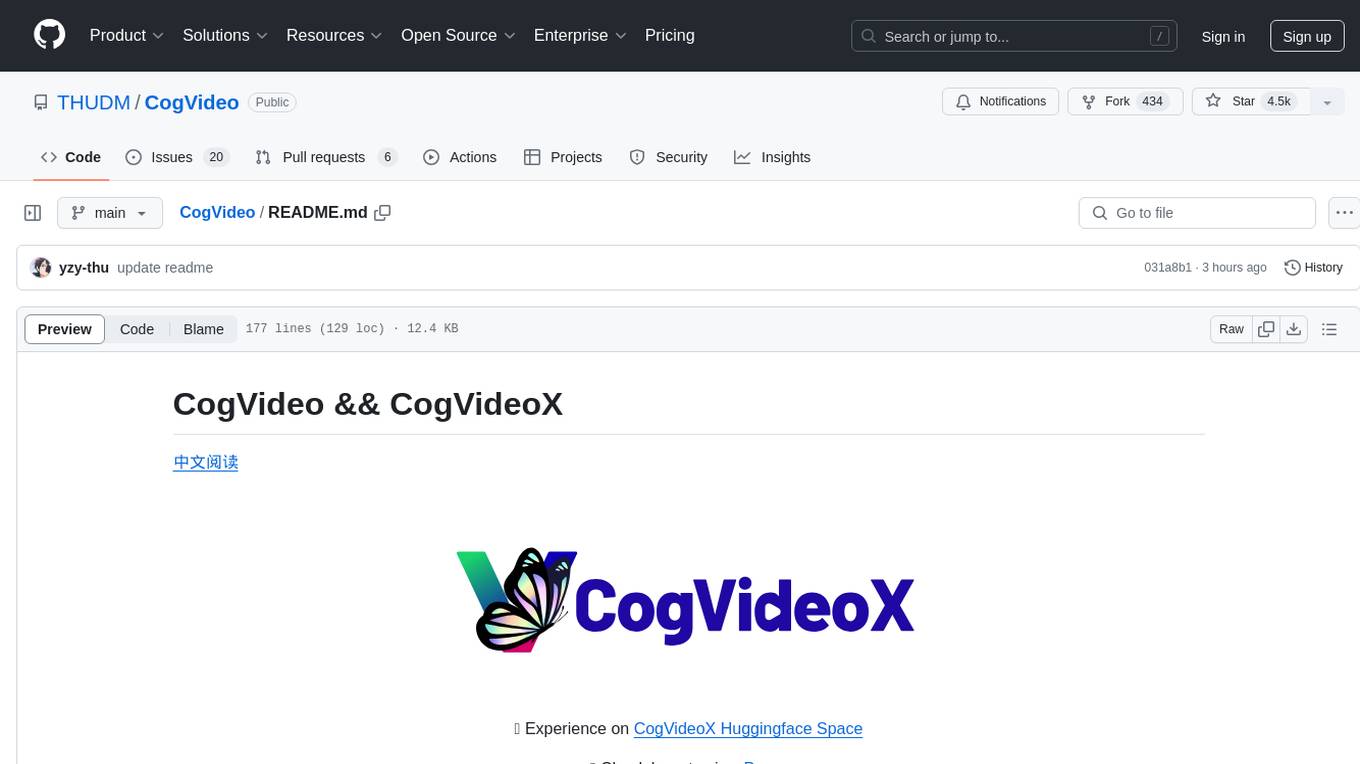
CogVideo
CogVideo is an open-source repository that provides pretrained text-to-video models for generating videos based on input text. It includes models like CogVideoX-2B and CogVideo, offering powerful video generation capabilities. The repository offers tools for inference, fine-tuning, and model conversion, along with demos showcasing the model's capabilities through CLI, web UI, and online experiences. CogVideo aims to facilitate the creation of high-quality videos from textual descriptions, catering to a wide range of applications.
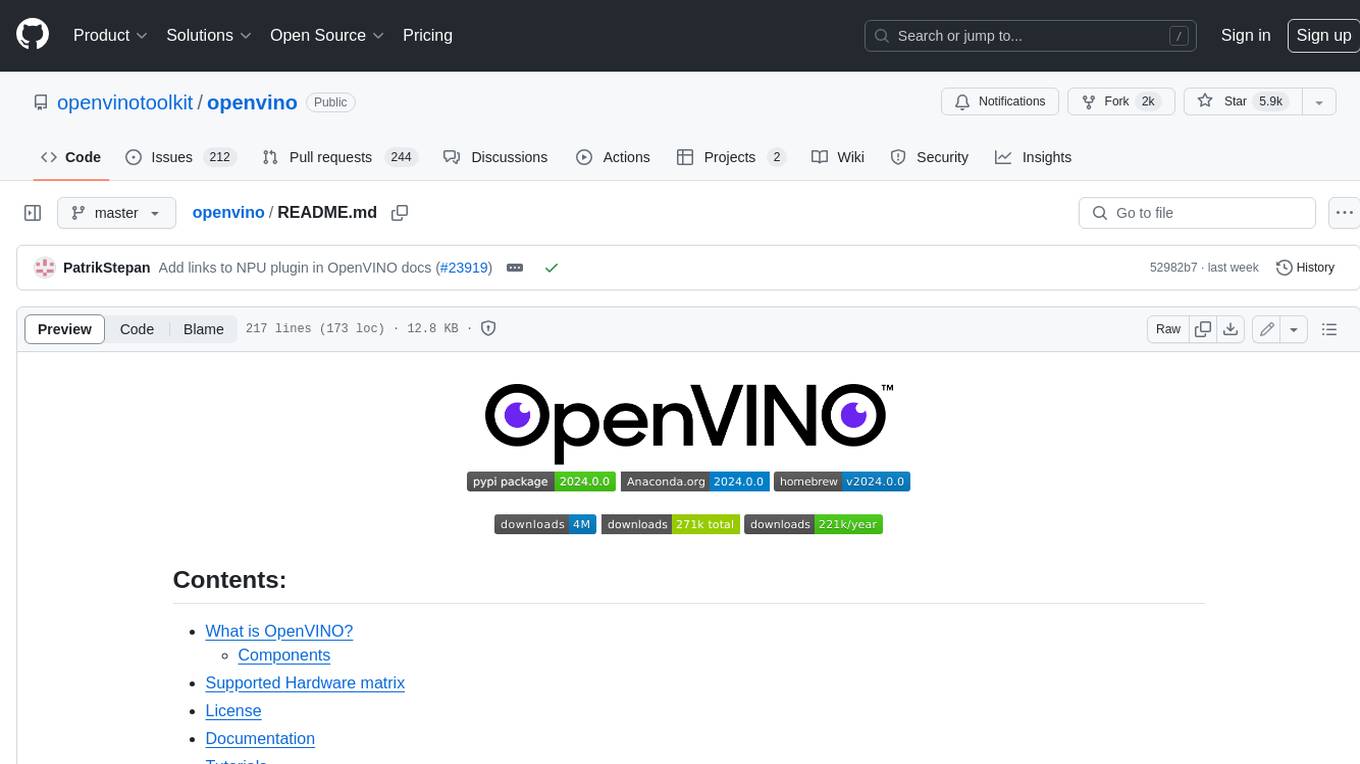
openvino
OpenVINO™ is an open-source toolkit for optimizing and deploying AI inference. It provides a common API to deliver inference solutions on various platforms, including CPU, GPU, NPU, and heterogeneous devices. OpenVINO™ supports pre-trained models from Open Model Zoo and popular frameworks like TensorFlow, PyTorch, and ONNX. Key components of OpenVINO™ include the OpenVINO™ Runtime, plugins for different hardware devices, frontends for reading models from native framework formats, and the OpenVINO Model Converter (OVC) for adjusting models for optimal execution on target devices.
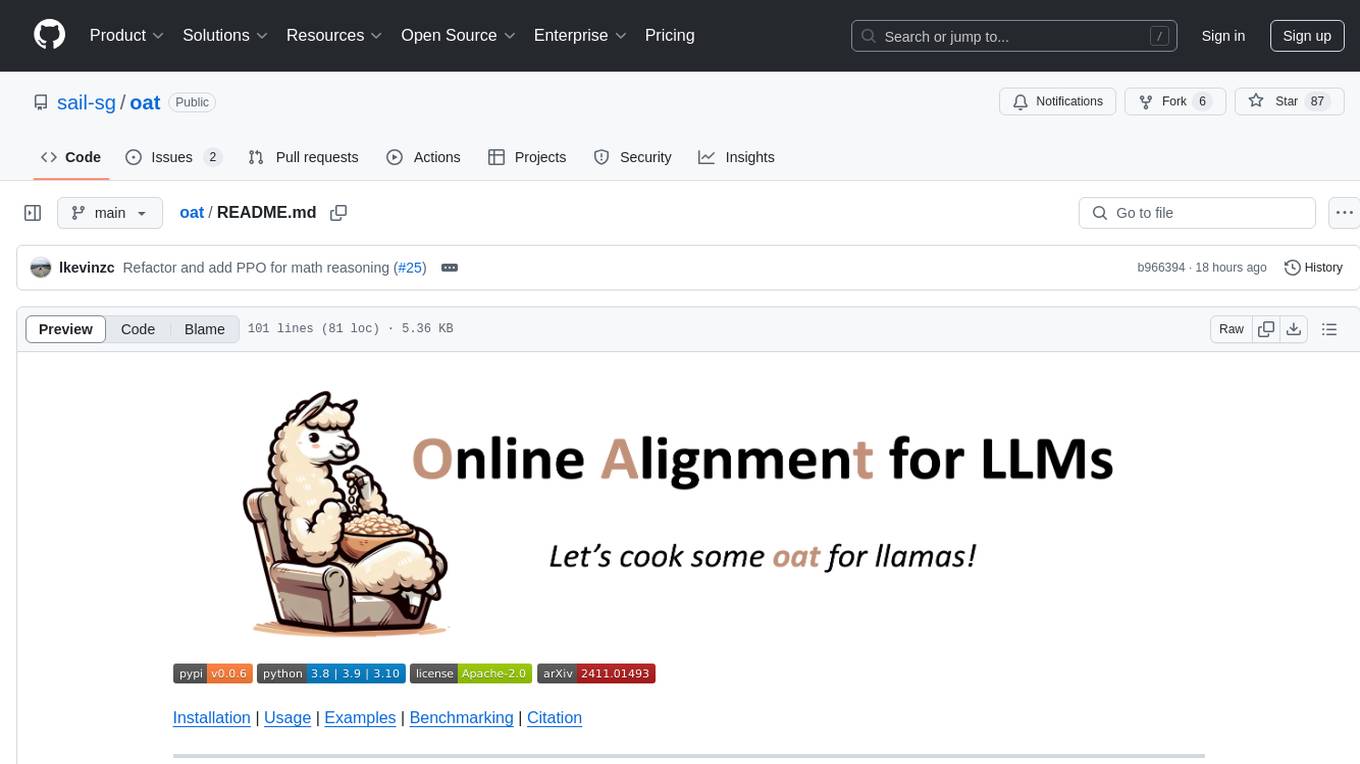
oat
Oat is a simple and efficient framework for running online LLM alignment algorithms. It implements a distributed Actor-Learner-Oracle architecture, with components optimized using state-of-the-art tools. Oat simplifies the experimental pipeline of LLM alignment by serving an Oracle online for preference data labeling and model evaluation. It provides a variety of oracles for simulating feedback and supports verifiable rewards. Oat's modular structure allows for easy inheritance and modification of classes, enabling rapid prototyping and experimentation with new algorithms. The framework implements cutting-edge online algorithms like PPO for math reasoning and various online exploration algorithms.
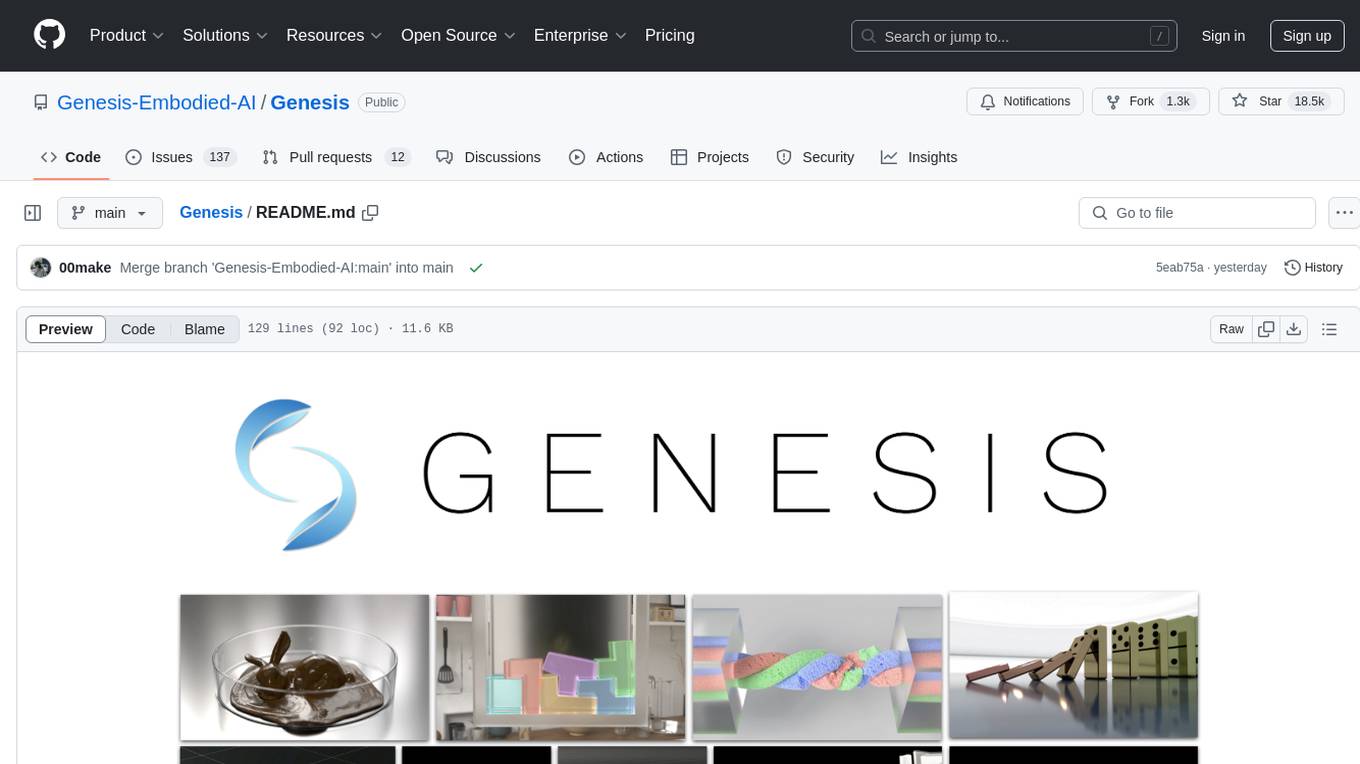
Genesis
Genesis is a physics platform designed for general purpose Robotics/Embodied AI/Physical AI applications. It includes a universal physics engine, a lightweight, ultra-fast, pythonic, and user-friendly robotics simulation platform, a powerful and fast photo-realistic rendering system, and a generative data engine that transforms user-prompted natural language description into various modalities of data. It aims to lower the barrier to using physics simulations, unify state-of-the-art physics solvers, and minimize human effort in collecting and generating data for robotics and other domains.
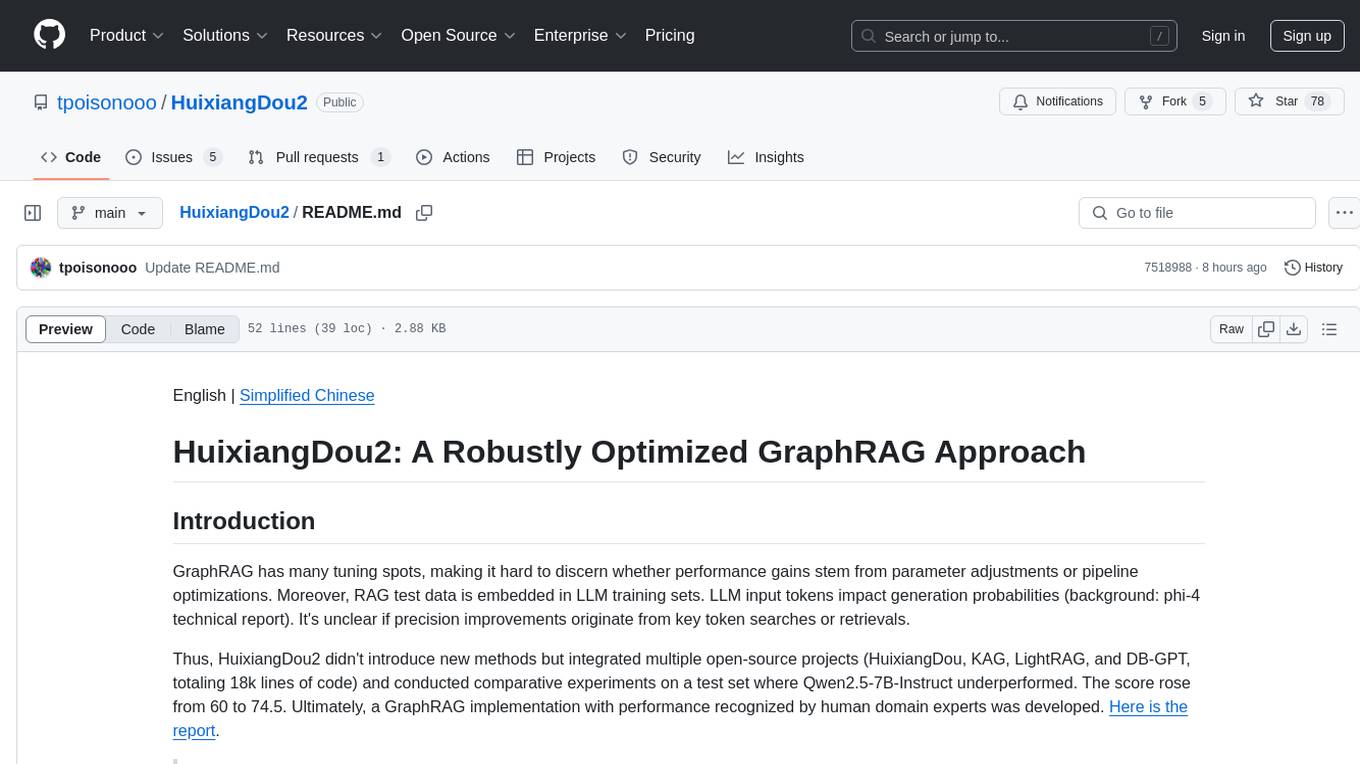
HuixiangDou2
HuixiangDou2 is a robustly optimized GraphRAG approach that integrates multiple open-source projects to improve performance in graph-based augmented generation. It conducts comparative experiments and achieves a significant score increase, leading to a GraphRAG implementation with recognized performance. The repository provides code improvements, dense retrieval for querying entities and relationships, real domain knowledge testing, and impact analysis on accuracy.
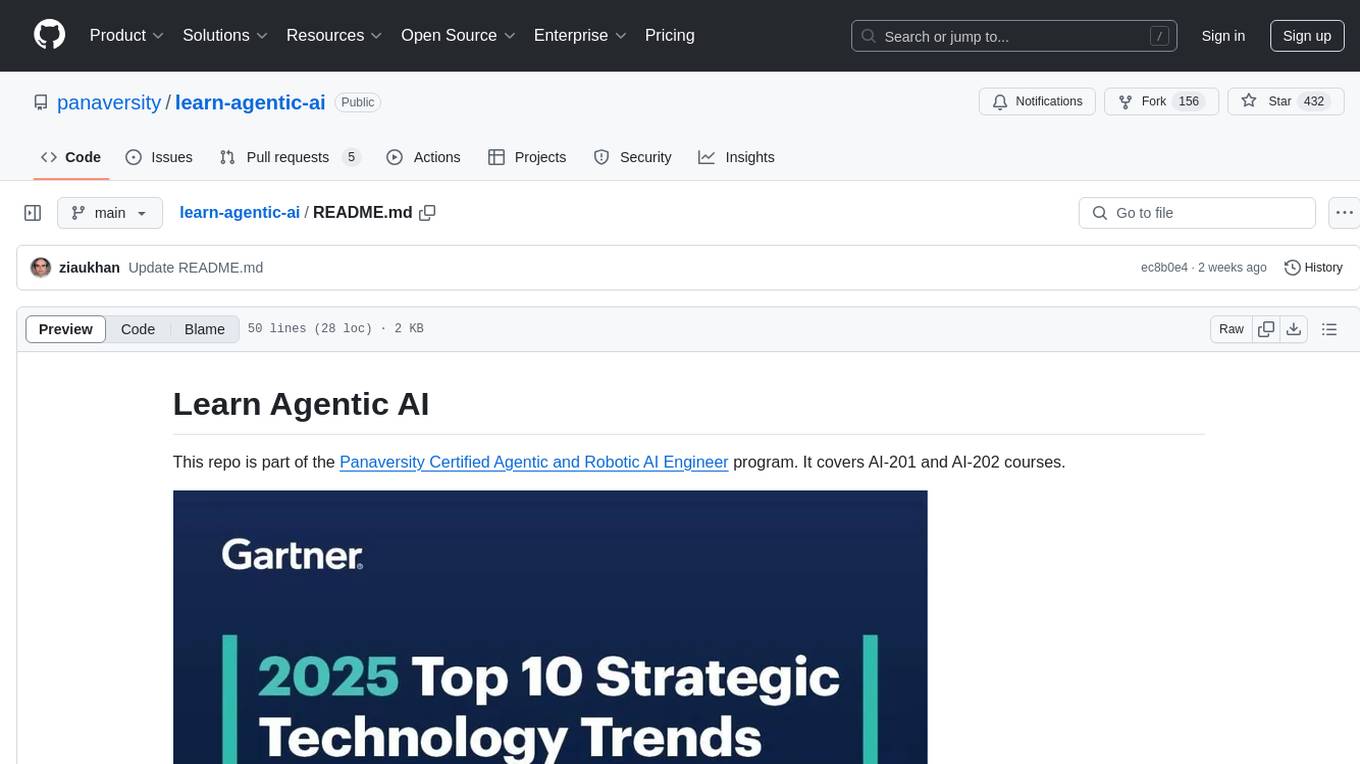
learn-agentic-ai
Learn Agentic AI is a repository that is part of the Panaversity Certified Agentic and Robotic AI Engineer program. It covers AI-201 and AI-202 courses, providing fundamentals and advanced knowledge in Agentic AI. The repository includes video playlists, projects, and project submission guidelines for students to enhance their understanding and skills in the field of AI engineering.
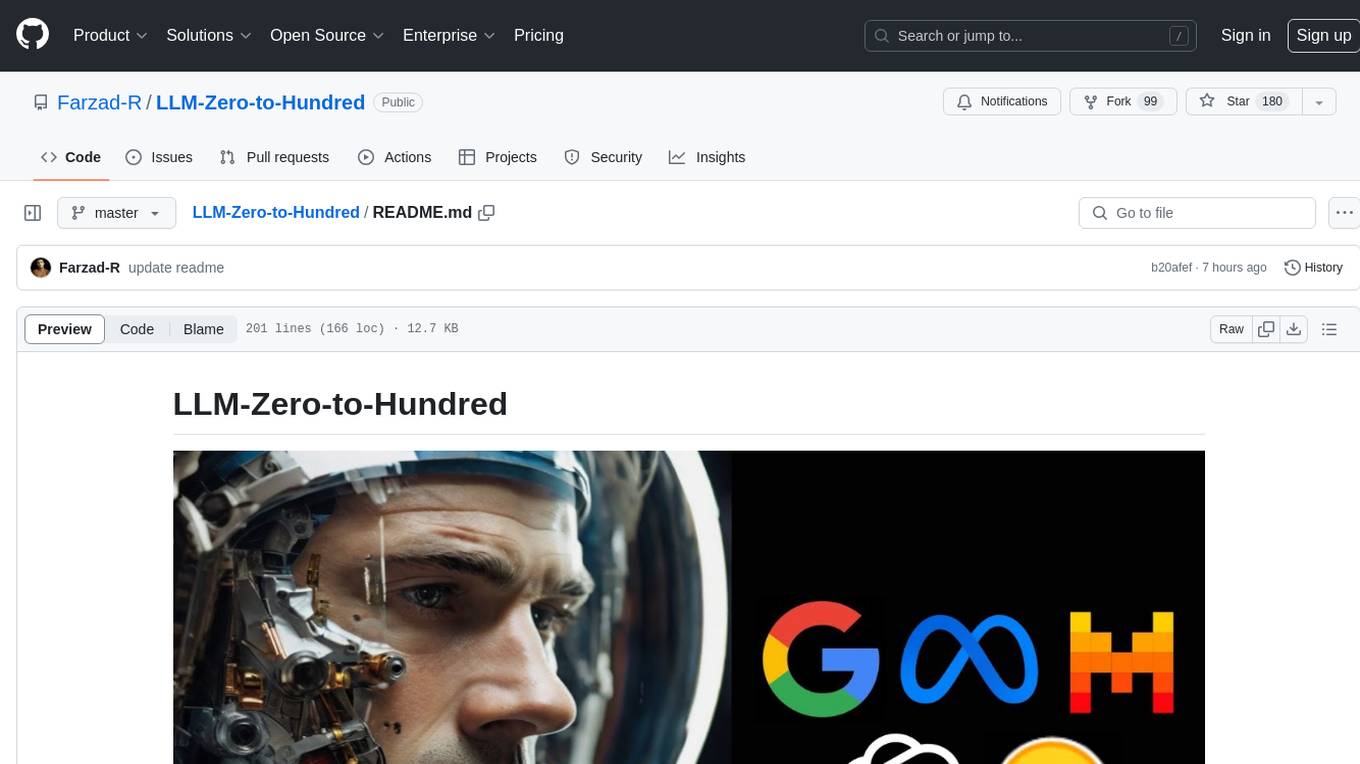
LLM-Zero-to-Hundred
LLM-Zero-to-Hundred is a repository showcasing various applications of LLM chatbots and providing insights into training and fine-tuning Language Models. It includes projects like WebGPT, RAG-GPT, WebRAGQuery, LLM Full Finetuning, RAG-Master LLamaindex vs Langchain, open-source-RAG-GEMMA, and HUMAIN: Advanced Multimodal, Multitask Chatbot. The projects cover features like ChatGPT-like interaction, RAG capabilities, image generation and understanding, DuckDuckGo integration, summarization, text and voice interaction, and memory access. Tutorials include LLM Function Calling and Visualizing Text Vectorization. The projects have a general structure with folders for README, HELPER, .env, configs, data, src, images, and utils.
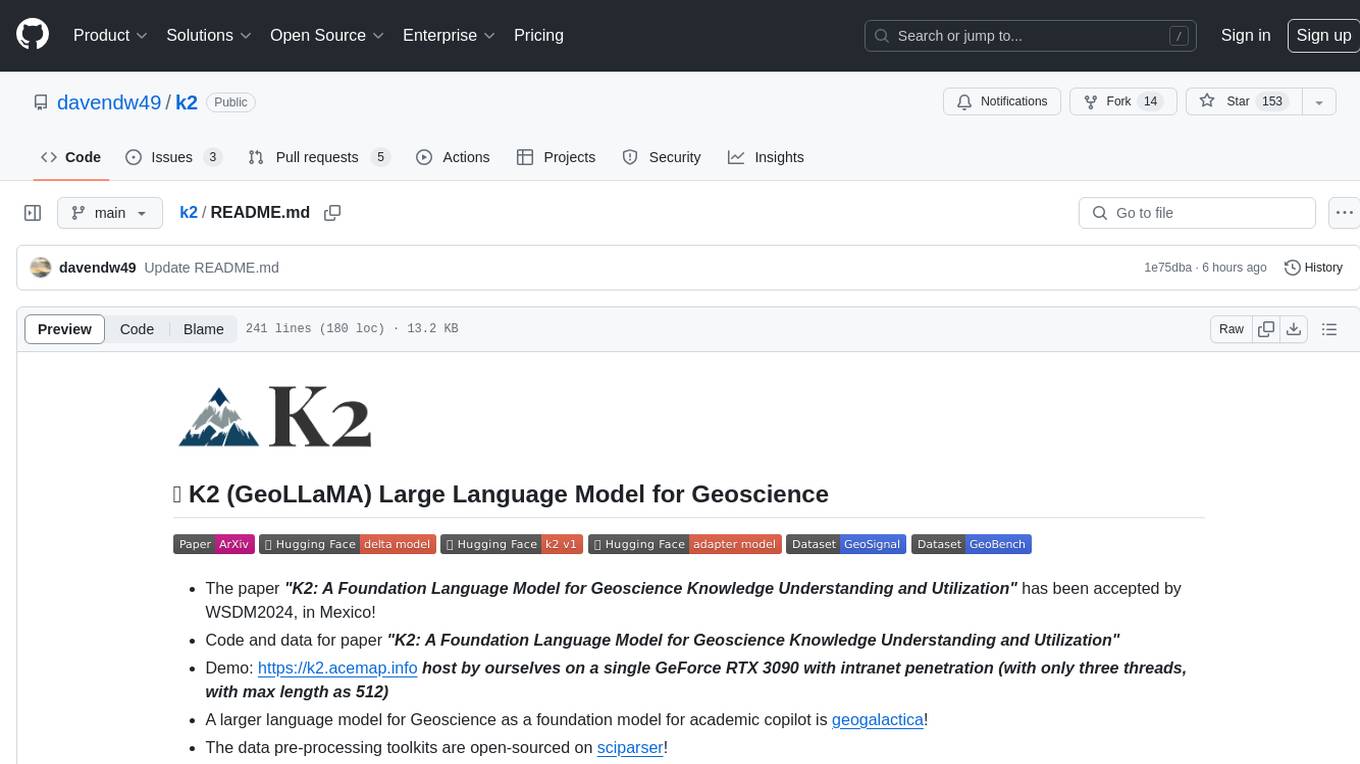
k2
K2 (GeoLLaMA) is a large language model for geoscience, trained on geoscience literature and fine-tuned with knowledge-intensive instruction data. It outperforms baseline models on objective and subjective tasks. The repository provides K2 weights, core data of GeoSignal, GeoBench benchmark, and code for further pretraining and instruction tuning. The model is available on Hugging Face for use. The project aims to create larger and more powerful geoscience language models in the future.
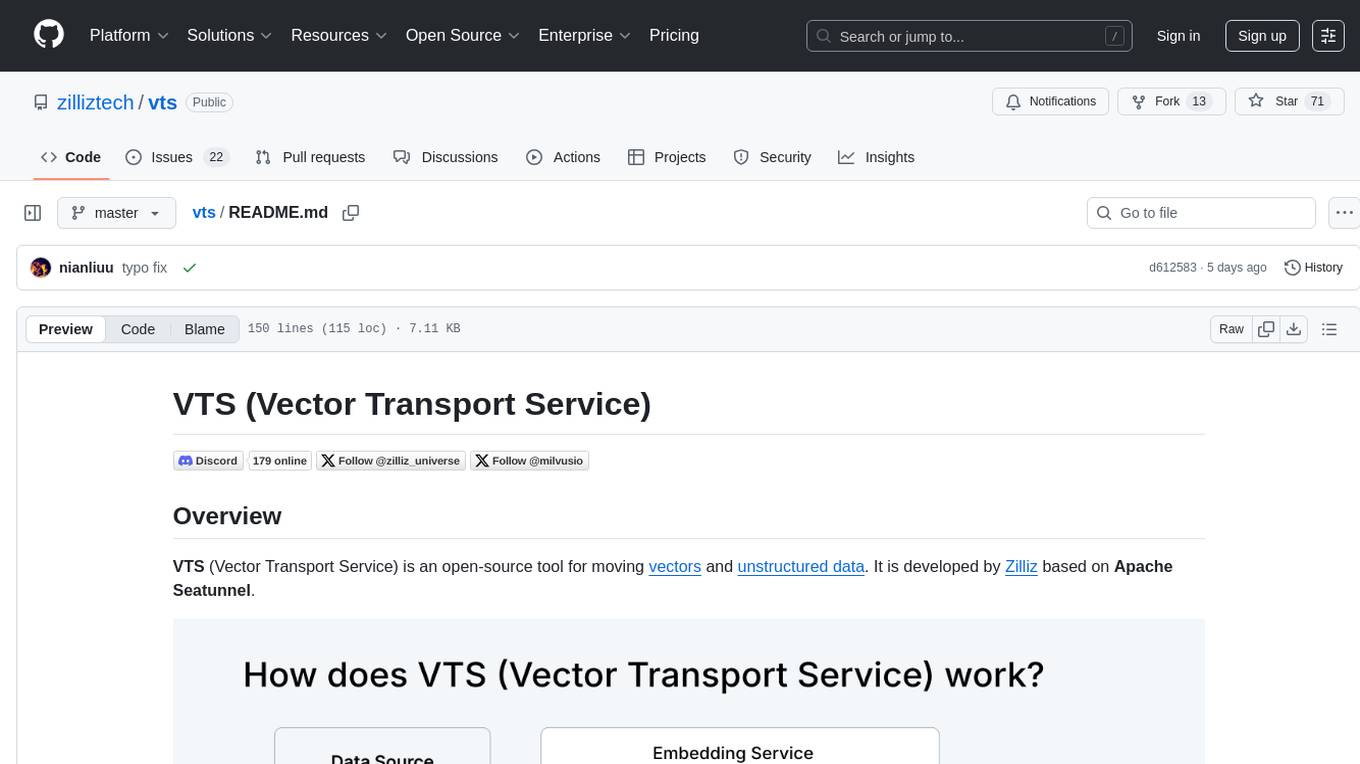
vts
VTS (Vector Transport Service) is an open-source tool developed by Zilliz based on Apache Seatunnel for moving vectors and unstructured data. It addresses data migration needs, supports real-time data streaming and offline import, simplifies unstructured data transformation, and ensures end-to-end data quality. Core capabilities include rich connectors, stream and batch processing, distributed snapshot support, high performance, and real-time monitoring. Future developments include incremental synchronization, advanced data transformation, and enhanced monitoring. VTS supports various connectors for data migration and offers advanced features like Transformers, cluster mode deployment, RESTful API, Docker deployment, and more.
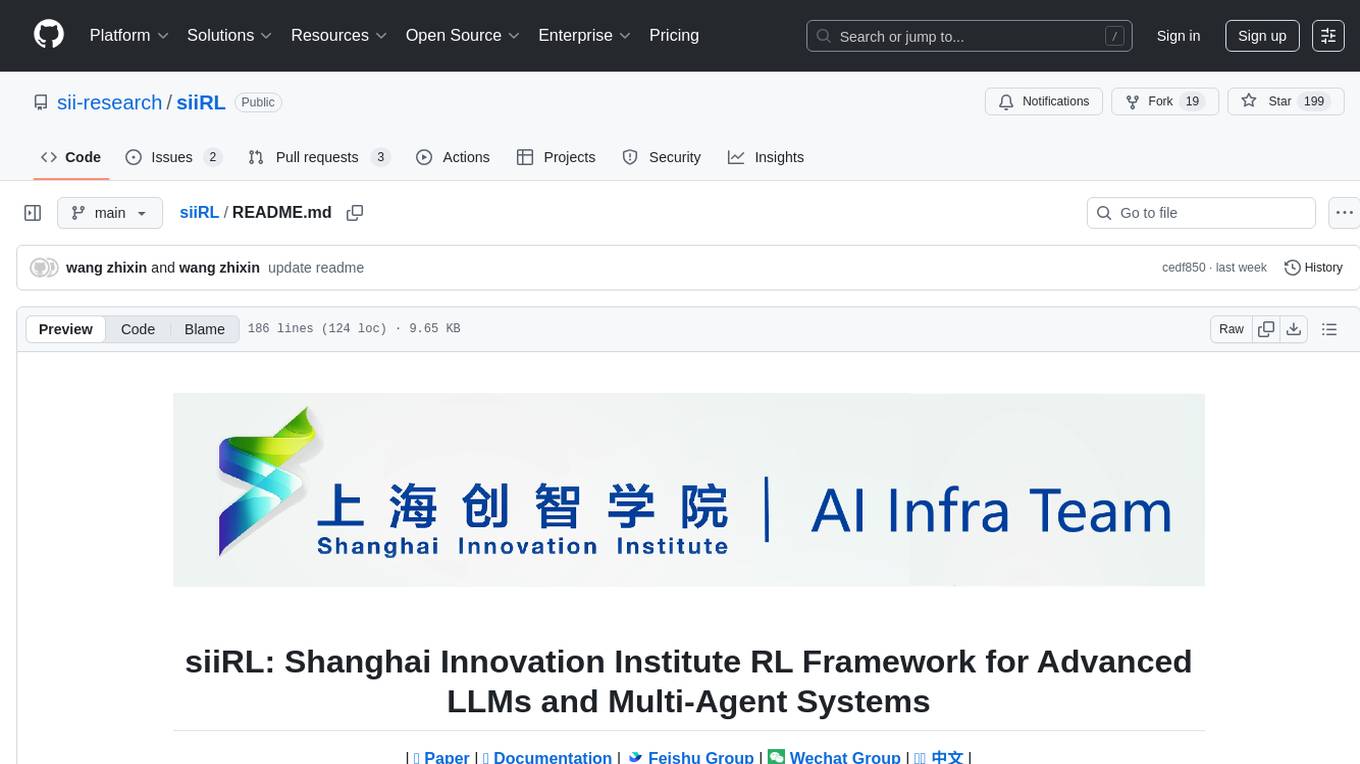
siiRL
siiRL is a novel, fully distributed reinforcement learning (RL) framework designed to break the scaling barriers in Large Language Models (LLMs) post-training. Developed by researchers from Shanghai Innovation Institute, siiRL delivers near-linear scalability, dramatic throughput gains, and unprecedented flexibility for RL-based LLM development. It eliminates the centralized controller common in other frameworks, enabling scalability to thousands of GPUs, achieving state-of-the-art throughput, and supporting cross-hardware compatibility. siiRL is extensively benchmarked and excels in data-intensive workloads such as long-context and multi-modal training.
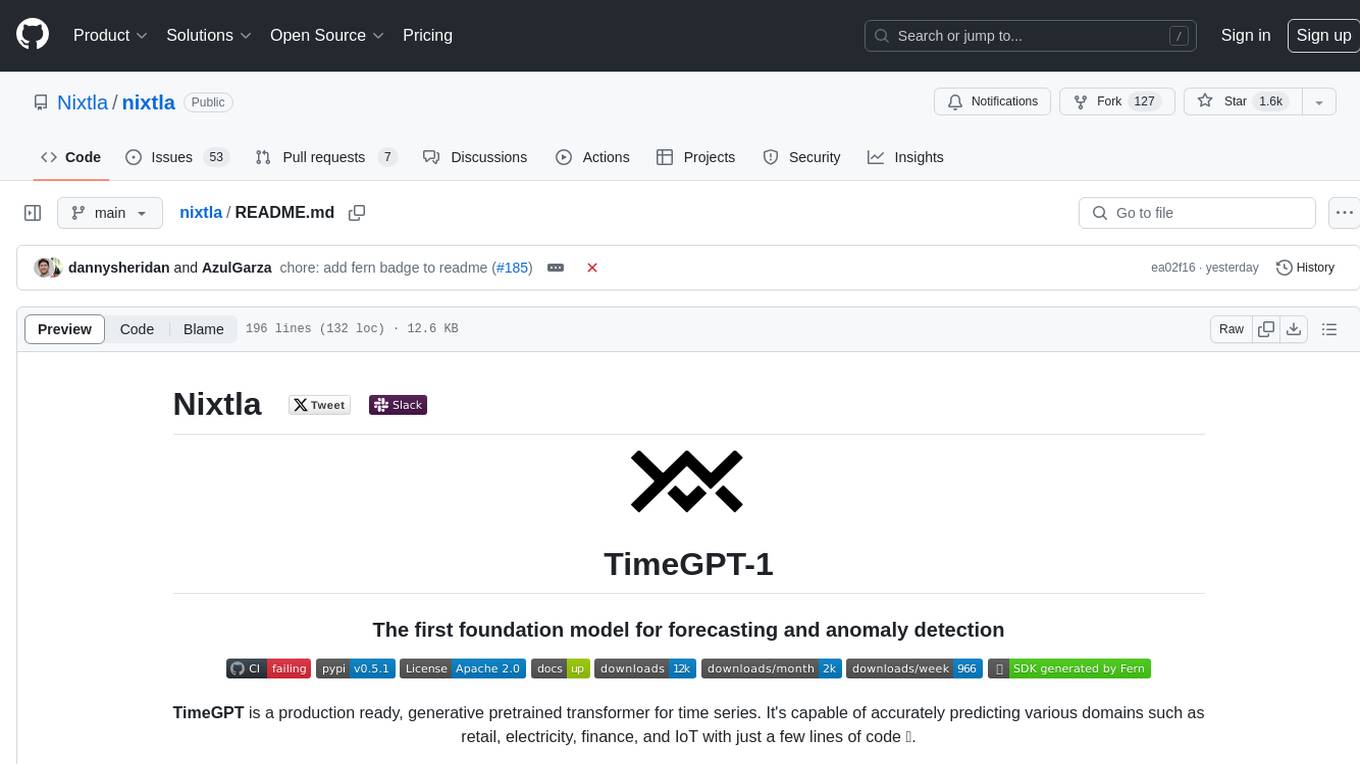
nixtla
Nixtla is a production-ready generative pretrained transformer for time series forecasting and anomaly detection. It can accurately predict various domains such as retail, electricity, finance, and IoT with just a few lines of code. TimeGPT introduces a paradigm shift with its standout performance, efficiency, and simplicity, making it accessible even to users with minimal coding experience. The model is based on self-attention and is independently trained on a vast time series dataset to minimize forecasting error. It offers features like zero-shot inference, fine-tuning, API access, adding exogenous variables, multiple series forecasting, custom loss function, cross-validation, prediction intervals, and handling irregular timestamps.
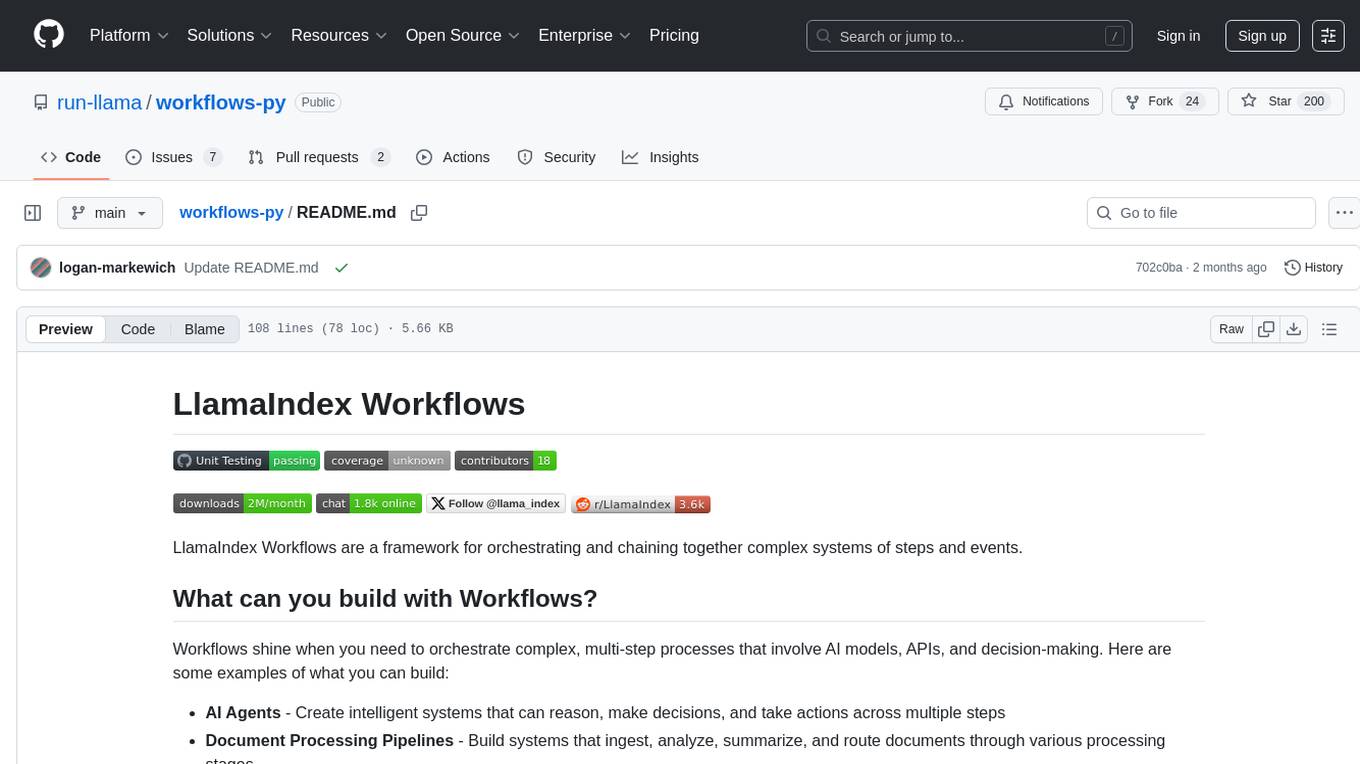
workflows-py
LlamaIndex Workflows is a framework for orchestrating and chaining together complex systems of steps and events. It shines in orchestrating complex, multi-step processes involving AI models, APIs, and decision-making. The async-first, event-driven architecture allows building workflows that can route between different capabilities, implement parallel processing patterns, loop over complex sequences, and maintain state across multiple steps. Key features include async-first design, event-driven structure, state management, and observability through tools like Arize Phoenix and OpenTelemetry.
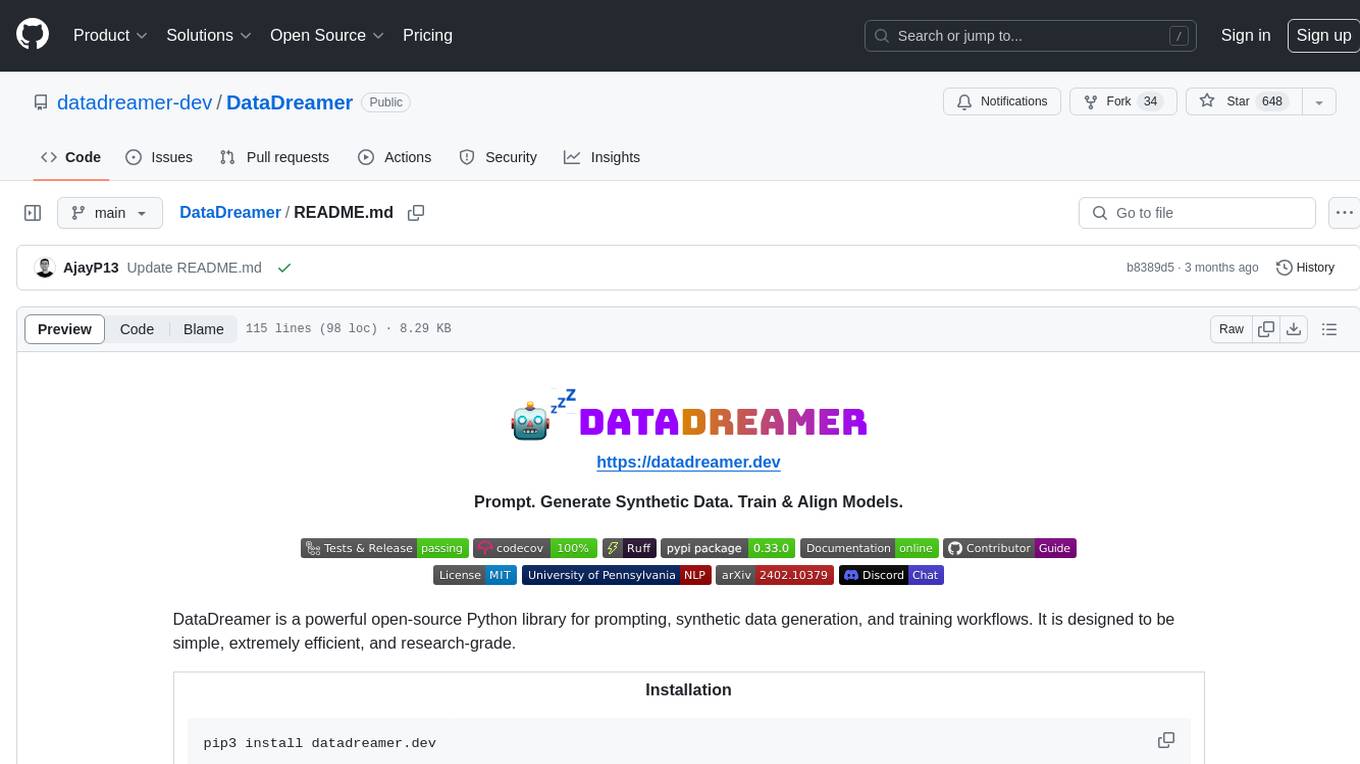
DataDreamer
DataDreamer is a powerful open-source Python library designed for prompting, synthetic data generation, and training workflows. It is simple, efficient, and research-grade, allowing users to create prompting workflows, generate synthetic datasets, and train models with ease. The library is built for researchers, by researchers, focusing on correctness, best practices, and reproducibility. It offers features like aggressive caching, resumability, support for bleeding-edge techniques, and easy sharing of datasets and models. DataDreamer enables users to run multi-step prompting workflows, generate synthetic datasets for various tasks, and train models by aligning, fine-tuning, instruction-tuning, and distilling them using existing or synthetic data.
For similar tasks

Mooncake
Mooncake is a serving platform for Kimi, a leading LLM service provided by Moonshot AI. It features a KVCache-centric disaggregated architecture that separates prefill and decoding clusters, leveraging underutilized CPU, DRAM, and SSD resources of the GPU cluster. Mooncake's scheduler balances throughput and latency-related SLOs, with a prediction-based early rejection policy for highly overloaded scenarios. It excels in long-context scenarios, achieving up to a 525% increase in throughput while handling 75% more requests under real workloads.
For similar jobs

AirGo
AirGo is a front and rear end separation, multi user, multi protocol proxy service management system, simple and easy to use. It supports vless, vmess, shadowsocks, and hysteria2.
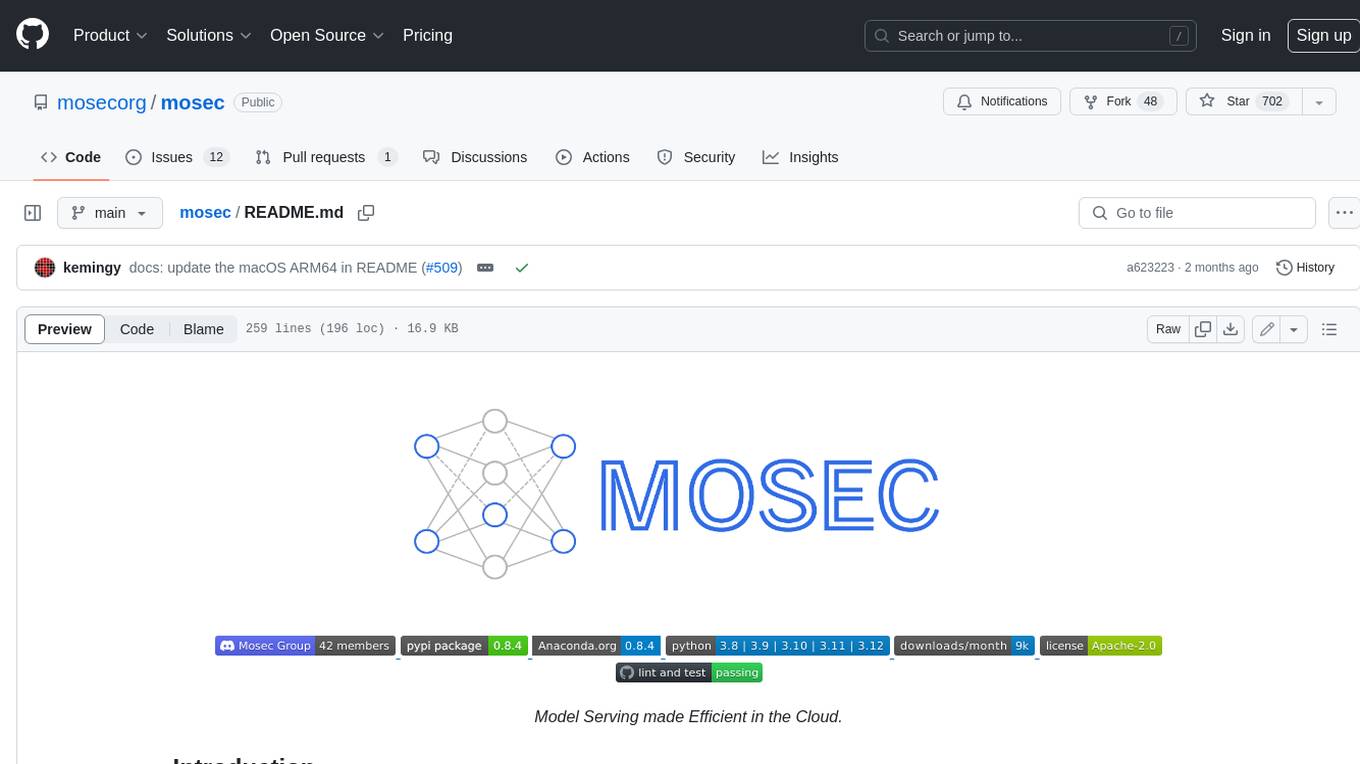
mosec
Mosec is a high-performance and flexible model serving framework for building ML model-enabled backend and microservices. It bridges the gap between any machine learning models you just trained and the efficient online service API. * **Highly performant** : web layer and task coordination built with Rust 🦀, which offers blazing speed in addition to efficient CPU utilization powered by async I/O * **Ease of use** : user interface purely in Python 🐍, by which users can serve their models in an ML framework-agnostic manner using the same code as they do for offline testing * **Dynamic batching** : aggregate requests from different users for batched inference and distribute results back * **Pipelined stages** : spawn multiple processes for pipelined stages to handle CPU/GPU/IO mixed workloads * **Cloud friendly** : designed to run in the cloud, with the model warmup, graceful shutdown, and Prometheus monitoring metrics, easily managed by Kubernetes or any container orchestration systems * **Do one thing well** : focus on the online serving part, users can pay attention to the model optimization and business logic
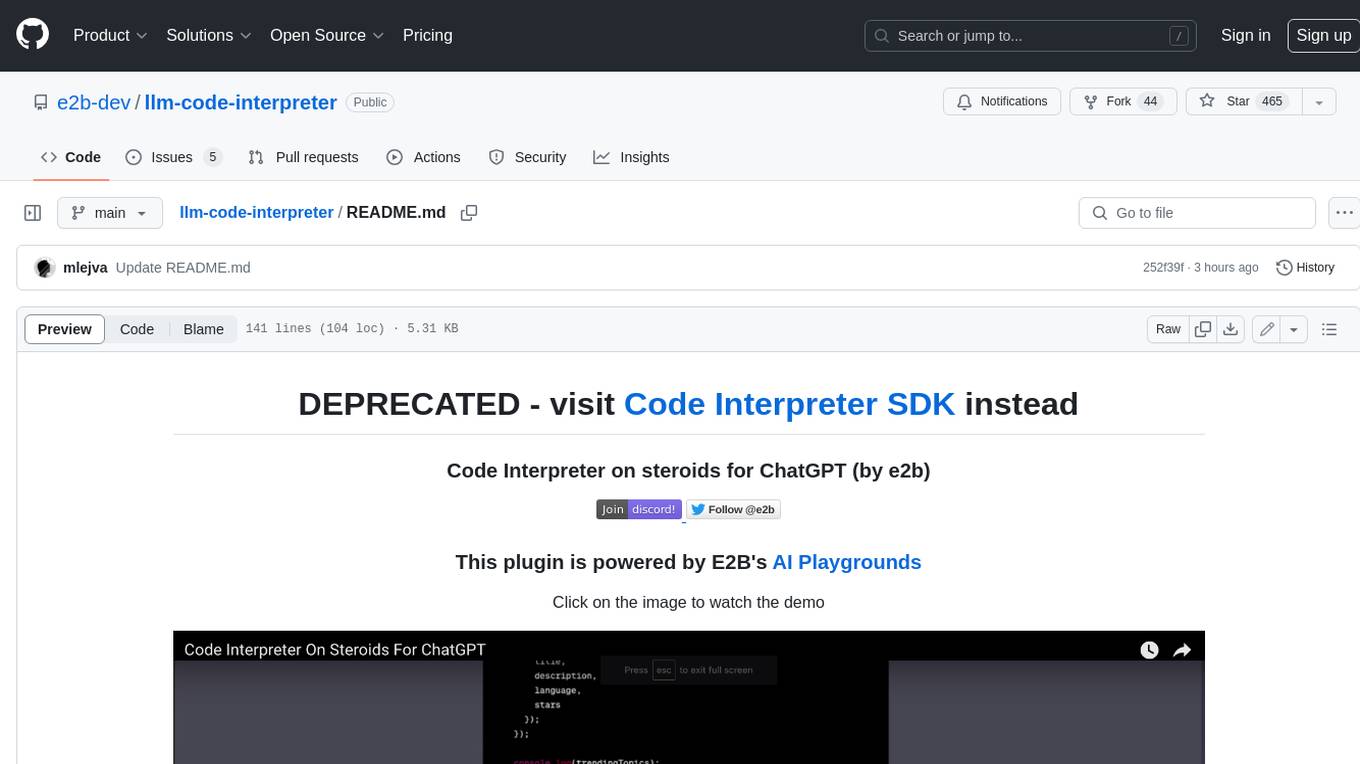
llm-code-interpreter
The 'llm-code-interpreter' repository is a deprecated plugin that provides a code interpreter on steroids for ChatGPT by E2B. It gives ChatGPT access to a sandboxed cloud environment with capabilities like running any code, accessing Linux OS, installing programs, using filesystem, running processes, and accessing the internet. The plugin exposes commands to run shell commands, read files, and write files, enabling various possibilities such as running different languages, installing programs, starting servers, deploying websites, and more. It is powered by the E2B API and is designed for agents to freely experiment within a sandboxed environment.

pezzo
Pezzo is a fully cloud-native and open-source LLMOps platform that allows users to observe and monitor AI operations, troubleshoot issues, save costs and latency, collaborate, manage prompts, and deliver AI changes instantly. It supports various clients for prompt management, observability, and caching. Users can run the full Pezzo stack locally using Docker Compose, with prerequisites including Node.js 18+, Docker, and a GraphQL Language Feature Support VSCode Extension. Contributions are welcome, and the source code is available under the Apache 2.0 License.
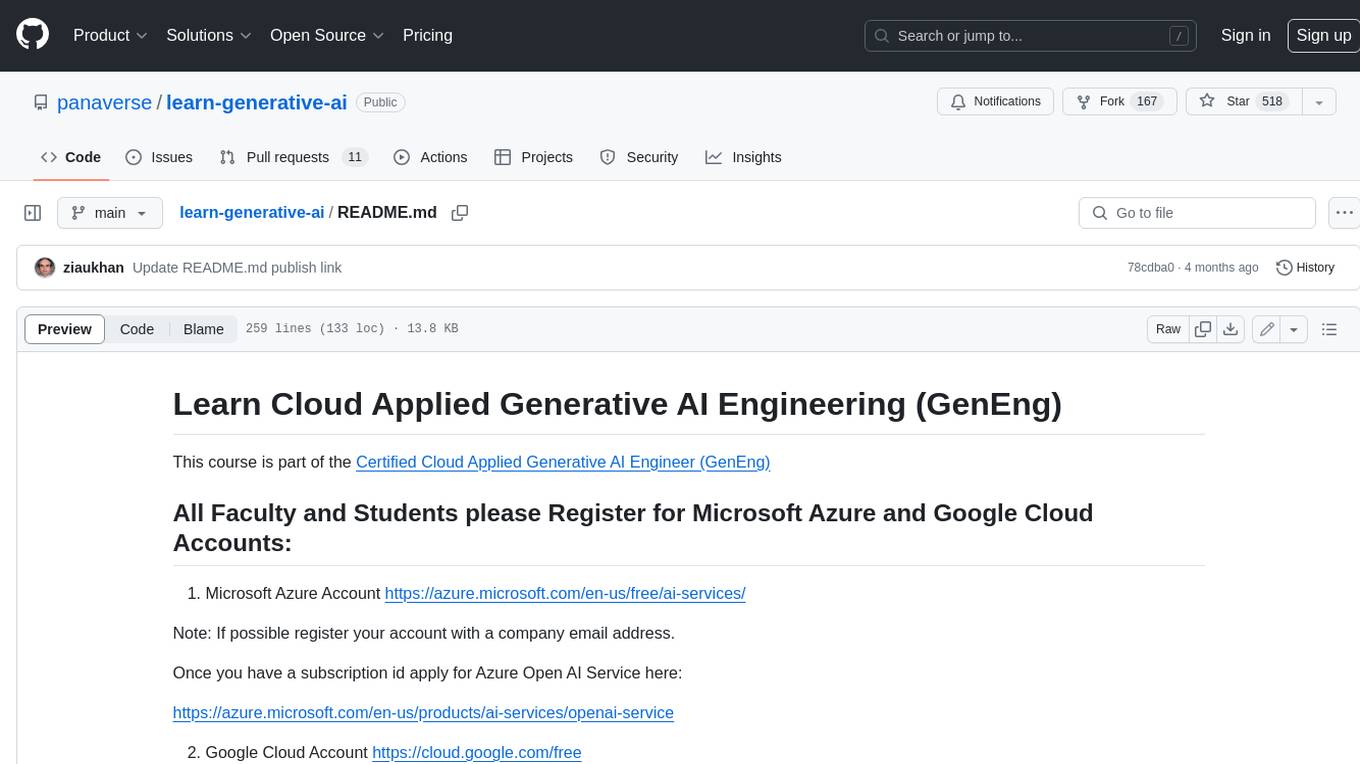
learn-generative-ai
Learn Cloud Applied Generative AI Engineering (GenEng) is a course focusing on the application of generative AI technologies in various industries. The course covers topics such as the economic impact of generative AI, the role of developers in adopting and integrating generative AI technologies, and the future trends in generative AI. Students will learn about tools like OpenAI API, LangChain, and Pinecone, and how to build and deploy Large Language Models (LLMs) for different applications. The course also explores the convergence of generative AI with Web 3.0 and its potential implications for decentralized intelligence.
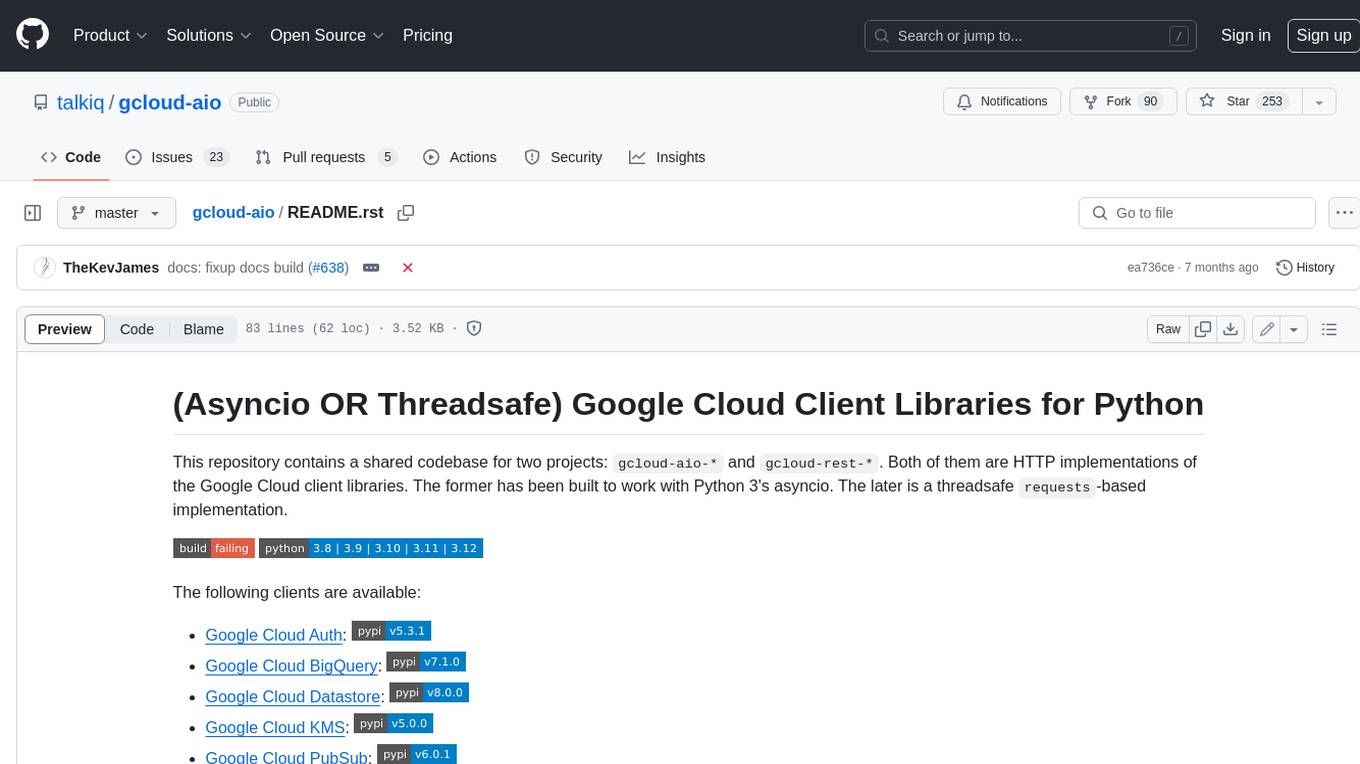
gcloud-aio
This repository contains shared codebase for two projects: gcloud-aio and gcloud-rest. gcloud-aio is built for Python 3's asyncio, while gcloud-rest is a threadsafe requests-based implementation. It provides clients for Google Cloud services like Auth, BigQuery, Datastore, KMS, PubSub, Storage, and Task Queue. Users can install the library using pip and refer to the documentation for usage details. Developers can contribute to the project by following the contribution guide.
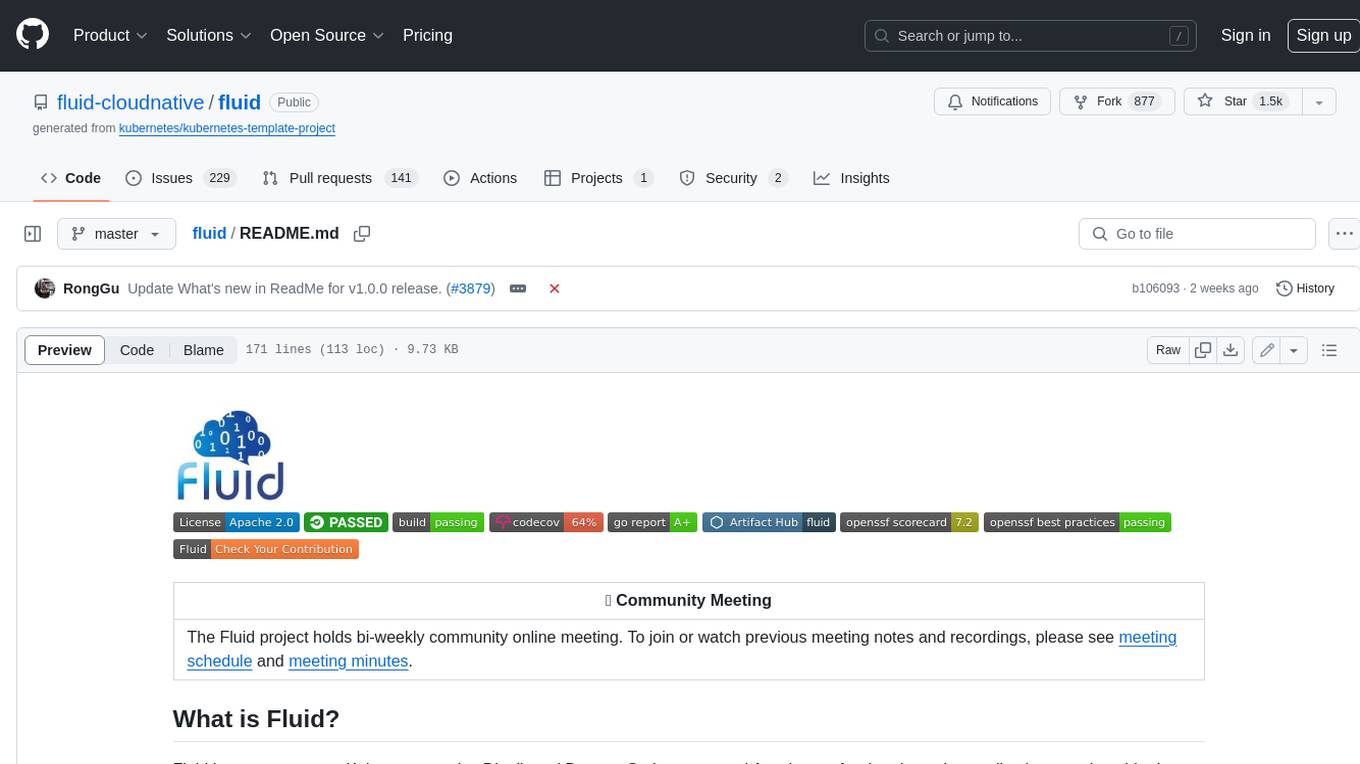
fluid
Fluid is an open source Kubernetes-native Distributed Dataset Orchestrator and Accelerator for data-intensive applications, such as big data and AI applications. It implements dataset abstraction, scalable cache runtime, automated data operations, elasticity and scheduling, and is runtime platform agnostic. Key concepts include Dataset and Runtime. Prerequisites include Kubernetes version > 1.16, Golang 1.18+, and Helm 3. The tool offers features like accelerating remote file accessing, machine learning, accelerating PVC, preloading dataset, and on-the-fly dataset cache scaling. Contributions are welcomed, and the project is under the Apache 2.0 license with a vendor-neutral approach.
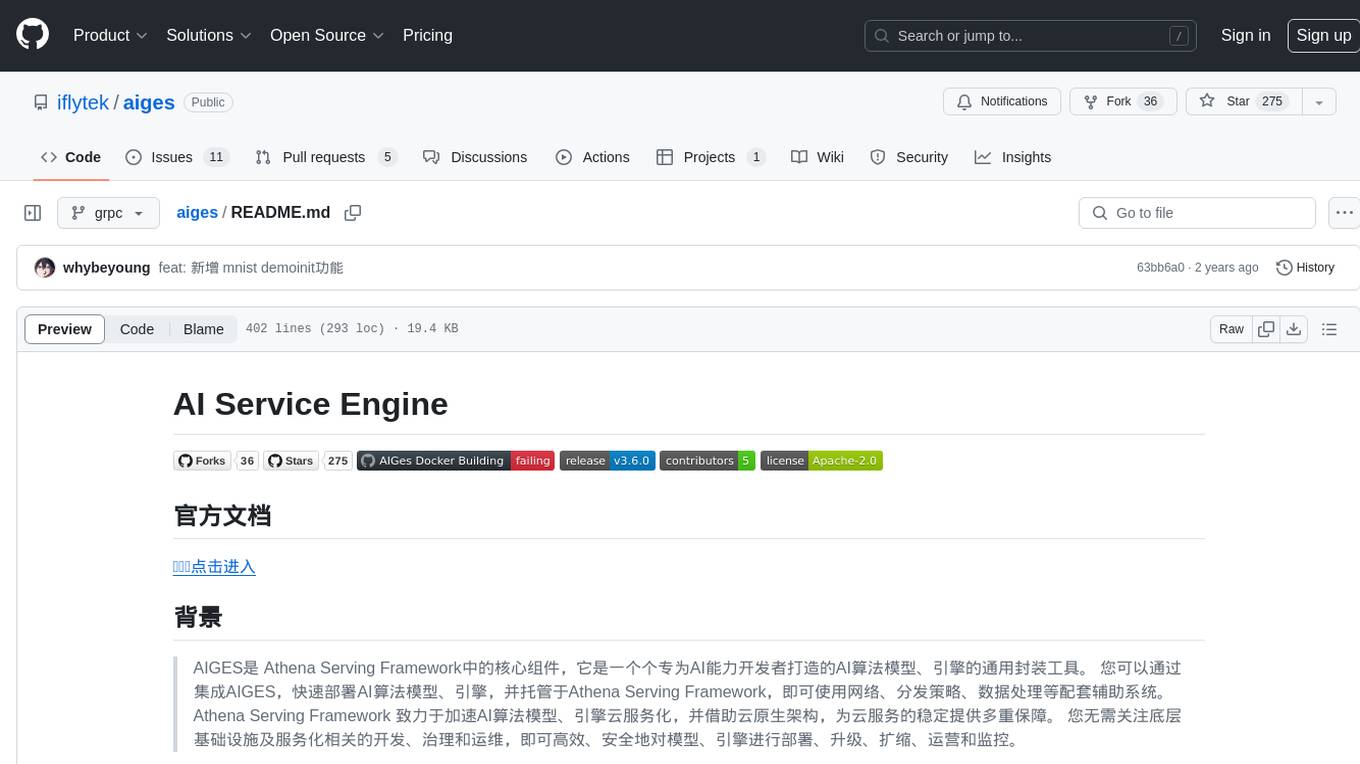
aiges
AIGES is a core component of the Athena Serving Framework, designed as a universal encapsulation tool for AI developers to deploy AI algorithm models and engines quickly. By integrating AIGES, you can deploy AI algorithm models and engines rapidly and host them on the Athena Serving Framework, utilizing supporting auxiliary systems for networking, distribution strategies, data processing, etc. The Athena Serving Framework aims to accelerate the cloud service of AI algorithm models and engines, providing multiple guarantees for cloud service stability through cloud-native architecture. You can efficiently and securely deploy, upgrade, scale, operate, and monitor models and engines without focusing on underlying infrastructure and service-related development, governance, and operations.







